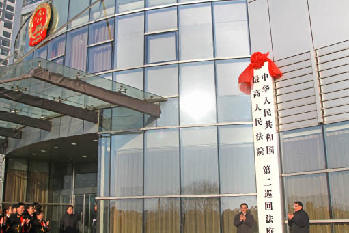Circuit Courts Promote Judicial Reform
By staff reporter HOU RUILI
 |
| The Second Circuit Court of the Supreme People’s Court. |
CHINA’s Supreme People’s Court established last January two circuit courts, one in Shenzhen, southern China’s pilot city for the reform and opening-up policy, and the other in the more conservative industrial city of Shenyang in Northeast China. Tasked with hearing major administrative, civil and commercial cases involving two or more administrative regions, these two circuit courts will set in motion China’s deepened judicial reforms.
Strengthen Judicial Independence
The concept of circuit courts is not new to China’s judicial system. There have been earlier, scattered tryouts. The recent establishment of those under the Supreme People’s Court, however, constitutes a large scale, institutionalized measure.
Circuit courts were frequently held in revolutionary base areas during the War of Chinese People’s Resistance Against Japanese Aggression and the Liberation War periods. Due to limited official premises, many cases were filed with and heard in situ in what were referred to as prairie, horse-back, maritime, and field courts.
In 1953, the Chinese government began its gradual establishment of circuit courts at the county level. The country revised its Civil Procedure Law in 1982 and stipulated a combined system of circuit and in situ trials. The 1991 modified provisions of the Civil Procedure Law hold that the People’s Court can hear cases, where appropriate, on the original site at a circuit trial.
In 2006, the government proposed “a sound circuit, an expanded scope of application of simplified procedures, and convenience of litigation for the masses.”
Until 2014 a system similar to that of the circuit court, whereby certain administrative cases filed with local intermediate courts are required to be transferred to intermediate courts of other regions, and some civil cases are handled in courts whose jurisdiction spans different administrative regions, was commonplace in China. These measures embody the continuous reform of China’s judicial system.
In October 2014, the Fourth Plenary Session of the 18th CPC Central Committee proposed optimizing judicial authority disposition, promoting pilot reforms aimed at separating judicial authority from executive authority, establishing circuit courts under the Supreme People’s Court, exploring the establishment of courts and procuratorates with jurisdictions spanning different administrative regions, and allowing prosecutors to institute public interest.
“The two circuit courts established by the Supreme People’s Court are the first institutionalized and immobilized circuit courts since the founding of the PRC,” vice director of Lawsuit System and Judicial Reform Research Center of Renmin University of China Cheng Lei said.
The steady rise in recent years of social problems in China is manifest in the growing volume of litigations. The Supreme People’s Court has heard more than 10,000 cases and registered 60,000 to 70,000 cases each year since 2010.
On January 1, 2007, the Supreme People’s Court took back the power of death penalty review that had been transferred to provincial courts in 1983. This change adds to the Supreme People’s Court the workload of at least 300 judges.
On October 28, 2007, the Standing Committee of the National People’s Congress passed the resolution to amend the Civil Procedure Law whereby parties that dispute a verdict or ruling that has come into effect can apply for a retrial at the higher-level court.
Since the final judgment of most cases is made at the Intermediate People’s Court or the Higher People’s Court, retrials are therefore submitted to the Higher People’s Court or the Supreme People’s Court.
“An influx of cases is detrimental to the Supreme People’s Court, the highest judicial organ, in its oversight function of guiding the work of regional courts, and also to the convenience of litigants,” Supreme People’s Court spokesman Sun Jungong said.
The establishment of the circuit courts will relieve the pressure of death sentence reviews and retrials and reduce extrajudicial disputes.
China has 3,573 local courts at different levels, the majority of which correspond to the division of administrative regions, according to General Office Director of the Supreme People’s Court Judicial Reform Leading Group He Xiaorong. As property is a local concern, legal matters in this connection are prey to local government influence and interference. The establishment of courts with jurisdictions spanning different administrative regions will fundamentally eliminate local government interference in the administration of justice and ensure impartial handling of cases involving local stakeholders.
